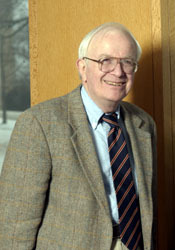… continuing our July conversation …..
STEWART MACAULAY
On defining New Legal Realism: I would stress the term “new” in New Legal Realism. This effort is Realist because it isn’t primarily focused on judges, legal rules, and elaborate system building after the fashion of Williston or Wigmore. NLR is interested in the consequences of law — both the intended and the unintended….
It is interested when people turn to normative and sanction systems other than the ones studied in law schools. It is “new” because only a few of the oldies did it, although many of them talked about it. Certainly, just as with the older movement, there is room for disagreement and differing points of view – no one owns the word “realism”. If you ask whether what we are doing fits within the Langdellian paradigm, we would clearly be out of bounds – for him, law was a science of doctrine and its laboratory was the law library. Somewhere there is a nice passage about all of that in Brainerd Currie’s two articles in the 1950s Journal of Legal Education about all of this.
On defining scholarly movements: In defining the boundaries of the older Legal Realism, Leiter speaks of “scholars who were identified with, or self-identified with, legal realism.” Would the Wisconsin people such as Hurst, Beuscher, and Remington have been known to Llewellyn, Cook, Moore, Frank and the happy little band of those scholars in the northeast part of the country? (Both Cook and Moore were Wisconsin law professors in the 1920s). The three Wisconsin professors certainly had read a great deal of what those scholars had written. Hurst was influenced by Frankfurter and Brandeis (he worked for both of them), and he saw history as a way to answer questions about if and how law contributed to the development of the economy of the United States. Hurst had a Harvard degree and great contacts with scholars from many fields, but he was interested in whether and how law mattered to those struggling to develop Wisconsin in the 19th and early 20th centuries. He was more interested in writing books than law review articles. He was skeptical about work focused on great cases; he saw broader patterns of legal action and failure to act as far more important. He was extremely well read, but I think that there would be far more history than social science on his bookshelves.
Beuscher had done graduate work at Yale, but he was more of a man of action, a reformer, who saw law as a tool. On the other hand, Beuscher had been influenced strongly, probably at Yale, by Erhlich’s idea of “living law.” There were norms and sanctions, but the stuff taught in law school was only part of the total. This could have been part of the “realism” of the time, but Beuscher rejected playing to the east. He had little interested in publishing in elite journals. He taught agricultural law (can you imagine such a course at Harvard, Yale or Columbia in the 1930s and 1940s?), and worked in what now would be called environmental law. He was an early participant in international efforts in reforming land tenure. Remington wanted to understand and to fix the criminal justice system. He was a law reformer who drafted a model criminal code, but he was influenced by his knowledge of what police actually did. Like Beuscher, he was not interested in writing articles for elite law journals. I think that all three had found things that they liked in the work of the east coast realists, but it wasn’t their club.
Interestingly, Llewellyn visited Madison in 1960, and Hurst entertained him at the Hursts’ house. According to those who were there, Llewellyn saw Hurst as being in his “realist” camp. I’m not sure how Hurst saw Llewellyn — Llewellyn was larger than life while Willard was a cautious person, at least as far as personal style went. So, was Llewellyn right about Hurst? Do we define who is “in” and who is “out” of an intellectual movement by a flow of ideas, by self-identification, or by the boundaries of social circles or institutions?
And what difference does it make to delineate sharp boundaries rather than looser ones? If we examine generations of scholars involved in closely-linked intellectual endeavors, we have to look more broadly and beyond the bounds of elite schools. If we stick tightly to a certain circle within that generation, we don’t have as much to read, but we may miss much of what happens… To be sure, one could say that it’s in the interest of current Wisconsin scholars to draw attention to their own legacy – but this ignores the other side of the coin: that interests are also served by erasing non-elite scholarly traditions, contributions, and forms of knowledge.

